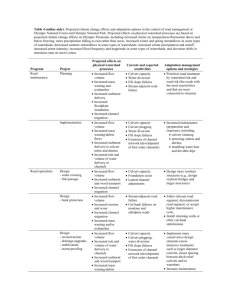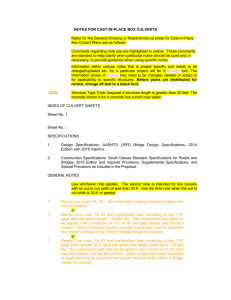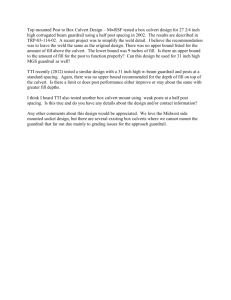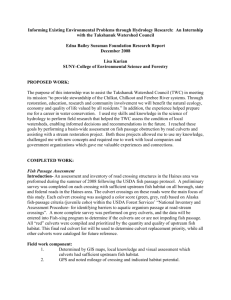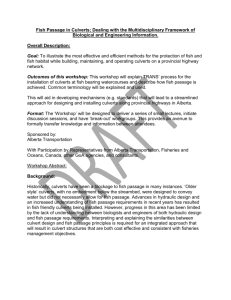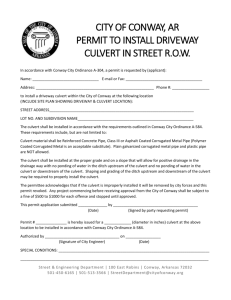Protocol for Fish Passage Determination of Closed Bottomed
advertisement
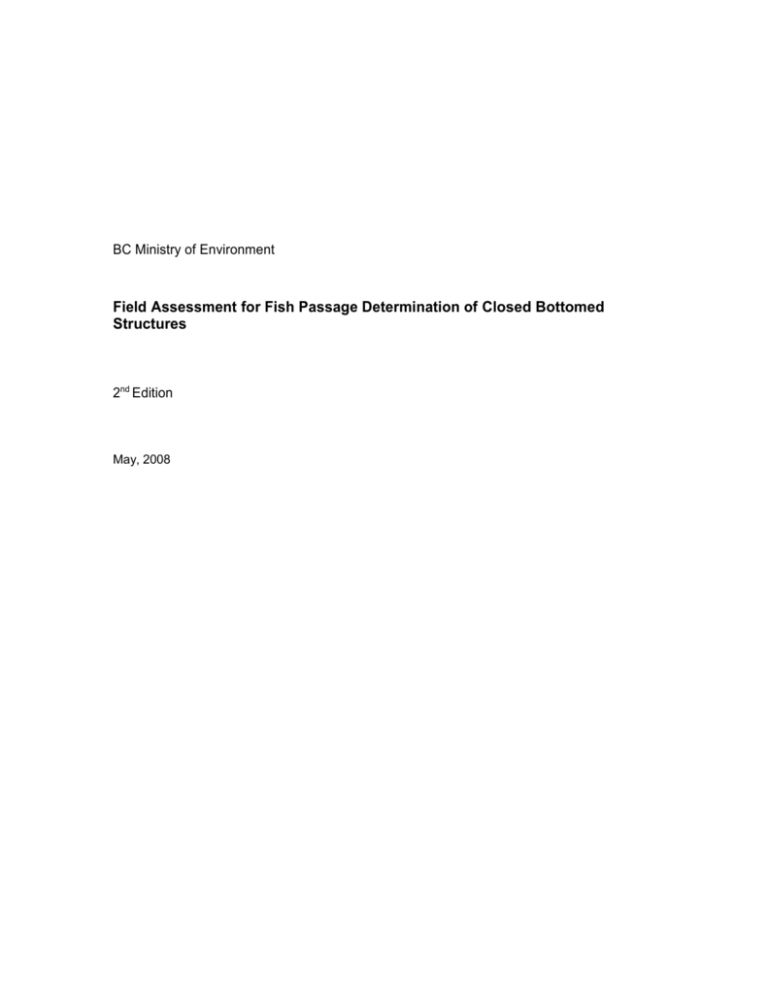
BC Ministry of Environment Field Assessment for Fish Passage Determination of Closed Bottomed Structures 2nd Edition May, 2008 Contents 1 Introduction ............................................................................................................................. 1 1.1 2 Background to the Protocol ............................................................................................ 2 Field Protocol .......................................................................................................................... 3 2.1 Crew Training ................................................................................................................. 3 2.2 Data Collection and Measurement Precision ................................................................. 4 3 Determination of a Barrier ..................................................................................................... 13 4 Use of Results ....................................................................................................................... 15 References .................................................................................................................................... 16 Appendix 1 ..................................................................................................................................... 17 i 1 Introduction Lack of fish passage at road crossings is a pervasive concern in British Columbia (Northcote and Hartman 2004). Surveys in the province and other jurisdictions consistently show that many culverted road crossings do not allow fish to pass (United States Government Accounting Office 2001; Northcote and Hartman 2004) because of issues related to velocity, turbulence, and perching. Culverts may be impassable under all flow conditions or during various fish life stages (e.g., juvenile vs. adult); many require retrofitting or replacing with more effective designs (Stream Enhancement Research Committee et al. 1980; Slaney and Zaldokas 1997). The protocol presented here summarizes the field component (Data Collection Phase) of a systematic, watershed-based process used to determine and restore fish passage at culverted fish-stream crossings. This process is outlined in a document entitled Fish Passage Assessment Protocol for Culverted Sites and illustrated in Figure 1 and available at http://www.for.gov.bc.ca/hcp/fia/landbase/fishpassage.htm. The results of these assessments are used in the process to develop an implementation plan for fish passage restoration. This field assessment provides a procedure to quickly answer the question: “Does this stream crossing likely provide safe fish passage?” The objective is to effectively answer this question in as little on-site time as possible. The protocol uses a cumulative scoring approach because determinations of fish passage often involve evaluating a suite of indicators rather than assigning a simple yes/no response to a single threshold value. Some background to this protocol follows this introduction. Section 2 outlines the required field information to collect and Section 3 provides the means to determine the likelihood that a crossing is a barrier to fish passage. The last section of the protocol describes the use of the assessment results. Appendix 1 contains an example of the field form used to collect assessment data. 1 Select watershed(s) using “Fish Values” and 1:50,000 Watershed Atlas Polygons 1. Planning Phase 2. Data Collection No further Phase Fish Passage? action Provide information to No 3. Analysis Phase informs Yes 4. Restoration Phase Data Analysis Implementation Plan Prepare maps showing road networks and known fish data Conduct Protocol for Fish Passage Determination of Closed Bottomed Structures to determine potential barrier Priorized List Regional Input Restore Fish Passage 5. Reporting Phase Report and Evaluate Figure 1: Fish Passage Assessment Protocol for Culverted Sites 1.1 Background to the Protocol Stream crossings are generally grouped into two main types—open bottom structures (OBS) and closed bottom structures (CBS). Open bottom structures include bridges and open bottom culverts (log and arch culverts). The most common closed bottom structures used on fish streams are corrugated pipes (primarily metal), which are ideally embedded to retain stream substrate and to provide fish habitat and passage. If CBS are not embedded and are placed on excessive slopes or where they constrict the natural stream channel, then one or more of the following conditions may jeopardize fish passage: An elevation drop at the outlet (downstream end of the culvert) Excessive velocities and (or) turbulence inside the culvert An area of high water velocity acceleration at the inlet 2 This protocol focuses on CBS because of problems associated with fish passage if these structures are not properly designed and installed (Slaney and Zaldokas 1997). It is based on principles related to those hydraulic conditions within, above, and below a stream crossing that are necessary to provide safe fish passage. The measurement of hydraulic surrogates allows the assessment to be done over a wide range of stream conditions. It should be noted, however, that “proving” fish passage is beyond the scope of this protocol. Conclusive proof of fish passage requires more detailed data on water velocity at different flow stages combined with fish sampling (minnow traps and electro-fishing) both up and downstream of culverts. Nevertheless, the assessments outlined here enable reasonable inferences to be made about the effectiveness of fish passage and the impact on fish habitat at these locations. Finally, the purpose of this protocol is to determine the likelihood that a culverted stream crossing provides safe fish passage; it should not be construed as providing design guidelines (for information on design, see the Fish Stream Crossing Guidebook, B.C. Ministry of Forests et al. [2002]). For instance, if a closed bottom culvert has adequate embedding material that is only 30 cm deep in some parts, it can probably pass fish. However, this depth of embedding would be inadequate for a new design that requires deeper embedding to ensure adequate roughness and cover. 2 Field Protocol For most stream crossings, the required field measurements should take no longer than 1015 minutes. For safety and efficiency, a crew of two should complete the assessments. Equipment List 2.1 rod and level (rod 5 m or longer for use where large fills are encountered) GPS unit clinometer 100 m fibre tape 25 m carpenter tape meter stick digital camera waders batteries data sheets and pencils felt pen laser range finder Crew Training The field assessment was designed to be undertaken by a two-person crew: one with a strong background in fish habitat and the other with relevant expertise in designing, costing, and installing CBS. It is important that all members of the field assessment 3 crew receive training regarding the application of this protocol. This ensures not only that the mechanics of the assessment are understood but, more importantly, that the concepts underlying the mechanics are understood. 2.2 Data Collection and Measurement Precision Figure 1 illustrates some of the terminology used in these assessments. Figure 2: Culvert Terminology The field form data components outlined in this section should be completed at the time of field assessment for all crossings. While not all the information collected is required to determine whether this crossing is a barrier, the baseline data recorded for the crossing provides a reference for further monitoring and enables the determination of a suitable retrofit or replacement. The information collected through the Assessment Methodology (see Appendix) falls into three broad categories as follows: 1. Location and survey data (i.e. date, UTM, crossing type, etc.) (Green) 2. Fish passage criteria (i.e. outlet drop, slope, channel width, etc.) (Red) 3. Site information to assist in identifying potential remedy and assist in priorization (i.e. depth of fill, valley fill, habitat value etc.) (Brown) Record all measurements to nearest whole number of the indicated unit (i.e., outlet drop 31 cm, 36 cm, etc.) except in the following cases: 1. Culvert width: Record to the nearest 100 mm (i.e., 1500 mm, 1800 mm, etc.). 2. Culvert slope (where measured with an auto level): Record to the nearest tenth of a percentage point (i.e., 2.4%). 3. Downstream width: Record to the nearest tenth of a meter (i.e., 3.6 m, 4.3 m, etc.). 4 The field form components are described in numerical order. Appendix 1 contains an example of the field form. 2.3 Location and Survey Data 1. Date: Enter date of inspection. 2. Crossing ID Number: Assign a unique number for each crossing surveyed. This is required to track the monitoring information collected at the site. Cross-reference the number with a set of maps so that information collected at the site can be retrieved at a later date. 3. Crew Names: Enter names of crew members taking measurements. 4. UTM/GPS: Record the co-ordinates of the crossing at the longitudinal centre using a GPS (NAD 83). Include UTM Zone, northing and easting. 5. Stream Name: Enter name from maps; if no name is given for the watercourse, then state to which stream it is a tributary (e.g., “Trib. to Bear Cr.”). 6. Road Name and Kilometer: Enter the road name by which it is best known, usually the forest road name (e.g., Owen Lake Forest Road). Record the road kilometer to the nearest 0.1 km and match the kilometer markers, if present. 7. MFR District: Record the name of the B.C. Ministry of Forest and Range district where the crossing is located. 8. Crossing Type (code): Circle the appropriate code for the crossing type: RC = Round Culvert; PA = Pipe Arch; EC = Embedded Round Culvert; EA = Embedded Pipe Arch. 2.4 Fish Passage Criteria 9. Embedded: There are three questions related to embeddment 1) Is the depth of embedding a minimum 30 cm, or 20% of the width or height of the culvert barrel, whichever is greater throughout the entire length of the culvert? Circle Yes or No2) If no to above, how far back into the culvert can substrate be found. Express as the % of the total culvert length. Choose the best category: 0, 25, 50, 75, or 100%. 5 3) Does the embedment material resemble that found within the natural channel (see example in Figure 2) with large enough material to provide sufficient hydraulic roughness and velocity shadows (see Figure 3), and is it fine enough to seal substrate to ensure surface flow during low flow periods? Circle Yes or No Figure 3: Examples of natural streambed material and embedment material. Figure 4: Large material creates “velocity shadows.” 6 10. Culvert Dimensions: For round culverts, measure diameter (to nearest 100 mm) with tape or meter stick at the outlet and estimate length (m) up the culvert. (Measure using laser range finder, or measure road surface and then estimate distance from road surface to end of pipe.) For other shapes (e.g., a pipe arch), enter three numbers: (1) span (width; to nearest 100 mm); (2) rise measured along with culvert length (height; to nearest 100 mm); (3) culvert length (m) estimated, or measured with tape or laser range finder. If (for other reasons) you will be walking up or down the inside of a larger culvert, then measure the length rather than estimating it. For culvert crossings with multiple pipes, record primary dimensions for the pipe that is lowest in elevation at the outlet. Follow these criteria when measuring the secondary pipes (9a-b). Measure diameter (to nearest 100 mm) and length (m) and record the invert elevation at the outlet in relation to the invert of the lowest or primary culvert (cm). If a culvert is plugged at the inlet, do not include it in these measurements. Record a comment if a culvert is lower in elevation at the inlet, but higher in elevation at the outlet than the primary culvert. When multiple culverts are present, take several pictures of the situation, especially if one of the culverts is plugged or has a different slope than the others. Note: For the barrier determination (Section 3.0, Figure 3) use the metrics from the pipe lowest in elevation at the outlet. For pipes installed at the same elevation at the outlet, add diameters for SWR criteria and use the highest slope, and length measurement. 11. Culvert Slope (%): Looking upstream in the culvert, estimate its slope using a clinometer (i.e., sight on a common spot in the culvert such as bolt line or the top of the culvert upstream). If the initial culvert slope is 4% or greater, then record the estimated slope (%). If the initial reading is less than 4%, then measure the slope with a level (nearest 0.1 %). 12. Downstream Channel Width (nearest 0.1 m): Stream channel width is the horizontal distance between the opposite stream banks, measured at right angles to the general orientation of the banks (see Figures 6 and 7). The methodology followed here is identical to that in the Fishstream Identification Guidebook (B.C. Ministry of Forests 1998) except that only three widths are required. To avoid measuring channel width in an area influenced by road clearing or culvert flows, take measurements below the influence of the outlet, usually downstream of the road right-of-way (clearing width). The width measured is the active width during normal high water, not the width that appears wetted when taking the measurements. The point on each bank from which width is measured is usually indicated by a definite change in vegetation and sediment texture. This border is sometimes shown by the edges of rooted terrestrial vegetation. Above this border, the soils and terrestrial plants appear undisturbed by recent stream erosion. Below this border, the banks typically show signs of both scour and sediment deposition. Indicators of high water may also include evidence of staining from turbid water, pieces of drift caught on 7 vegetation (these look like small bird nests), and the crest of banks on low-gradient, unconfined alluvial streams. Multiple Channels To determine the stream channel width where multiple channels are present, include all unvegetated gravel bars in the measurement (these usually show signs of recent scour or deposition). If multiple channels are separated by one or more vegetated islands, then calculate the width as the sum of all the separate channel widths; exclude the islands from the measurement. Figure 5: Stream channel width. 8 Figure 6: Illustrations of stream channel width. Wetland or Lake Immediately Downstream If a lake or wetland occurs immediately downstream from the road crossing, then take width measurements upstream of the crossing instead of downstream. Take several channel widths upstream to obtain an accurate width measurement that is free of crossing effects. If the crossing has lakes and wetlands both upstream and downstream, then do not take width measurements. In this case, record some comments about the size of the culvert and any evidence of overtopping. Overtopping evidence includes drift material on the crossing fill at a higher elevation than the crossing, or indications of water erosion on the road surface. 13. Outlet Drop (cm): The outlet drop distance between the culvert invert and outlet control as shown in Fig. 5. 9 Culvert invert Outlet drop Outlet control Residual pool depth Figure 7: Outlet drop is the hang height plus the riffle crest depth 2.5 Site information This information is used in identifying potential remedy and assist in priorization (i.e. depth of fill, valley fill, habitat value etc.) 14. Outlet Residual Pool Depth (cm): Record residual pool depth (see Figure 5; i.e., the difference in elevation of the outlet control to the deepest place in the downstream pool). Simply measure the maximum water depth in the pool downstream of the crossing and then measure and subtract the water depth at the outlet control. 15. Downstream Stream Slope (%): Measure the slope of the section downstream of the downstream riffle or weir (or at least 6 m downstream) with the clinometer. If the stream is at the confluence of a lake, wetland, or larger river, then measure the slope of a section at least two channel widths (or 6 m) upstream. 16. Habitat Value: Evaluate the habitat value at the crossing site and record as High, Moderate, or Low. When evaluating, try to achieve consensus among assessment team members. Place particular emphasis on habitat upstream of the CBS as this is the habitat that will be gained when fish passage is restored. Table 1 presents some habitat value criteria to guide the evaluation. Habitat value is to be recorded as high, medium or low. Try and arrive at consensus among the assessment team. 10 Table 1: Habitat Value Criteria Habitat u/s of Crossing Site Fish Habitat Criteria High Moderate Low The presence of high-value spawning or rearing habitat (e.g. locations with abundance of suitably sized gravels deep pools, undercut banks, or stable debris, which are critical to the fish population downstream of the subject crossing Important migration corridor Presence of suitable spawning habitat Habitat with moderate rearing potential for the fish species present The absence of suitable spawning habitat, and habitat with low rearing potential (eg. locations with distinct absence of deep pools, undercut banks, or stable debris, and with little or no suitably sized spawning gravels for the fish species present 17. Depth of Fill (cm): Record the average depth of fill over the culvert. This measurement is an estimate of the amount of road fill above the culvert and is used to estimate the cost of removal during the analysis phase of the overall protocol document 18. Valley Fill: Circle the appropriate code in response to the question: Is there evidence of a deep valley, or is the stream running on bedrock, or is on shallow fill over bedrock? For wide valleys the answer is usually deep fill (DF). If bedrock occasionally shows on the stream, then shallow fill (SF) will be the answer. If a large area of bedrock is evident, then the answer is bedrock (BR). This attribute is important in determining whether a closed bottom structure is appropriate as a possible replacement design. 19. Beaver Activity: Circle Yes or No. Evidence of beaver activity is usually most pronounced on the upstream (inlet) side of the culvert. This is a maintenance issue and may influence restoration options.Devices or fencing will often be installed to inhibit beaver activity at the inlet. If beaver devices (such as cages) or fencing occur near the inlet, then record this as beaver activity and describe the device in comments. Take extra photographs of the situation. 20. Inlet Drop: Circle Yes or No in response to the following question: Is there a drop between the streambed elevation and the invert of the culvert at the inlet? 21. Backwatered: Backwatering refers to the damming (or back-up) of water as a result of a downstream control (e.g., weir or debris jam). This slows water flow and raises water height above the invert of the CBS. Backwatered conditions are easy to recognize: simply throw a rock in the water. If the waves from the thrown rock move upstream before being washed downstream, then backwatering or damming is occurring downstream. Also, 11 backwatered areas have minimal water surface slopes and often have a glassy or relatively smooth appearance. How far does the outlet pool fill back into the culvert? Express as the % of the total culvert length. Choose the best category: 0, 25, 50, 75, or 100% as shown in the figure below. 22. Fish Sighted: If fish are observed at the crossing, then circle Yes on the form. If these fish are identified as species included in the Forest Practices Code definition of a fish stream, then circle FPC. Note where fish seen i.e. upstream, downstream, etc. 23. Culvert Fix: If the stream fails to meet fish passage criteria and the assessment team concludes that it does not pass fish (see Section 3), recommend an appropriate fix from the following (circle one or more): 1. (RM) Removal of the structure and deactivation of the road if access is not required. May not be able to conclusively decide this at time of assessment 2. (OBS) Replacing the culvert with a bridge or other open bottom structure. Note proposed span and any other aspects of OBS deemed relevant. 3. (SS) Replacing the structure with a streambed simulation design culvert. Note proposed length of culvert. 4. (EM) Adding substrate material to the culvert and possibly a downstream weir to reduce overall velocity and turbulence and provide low velocity areas. Note: This option should be considered only on sites where there is no Outlet Drop (OD), slope < 1.0 %, Stream Width Ratio (SWR) less than 1.0. Design and installation should not impact flood event design. 12 5. (BW) Backwatering the structure to reduce velocity and turbulence. Note: This option should be considered only on sites where OD < 30 cm., slope < 2.0 %, Stream Width Ratio (SWR) less than 1.2 and stream profiling indicates it would be effective. Design of downstream weirs should be given careful consideration and based on a detailed stream profile. Backwatering design requires additional information for proper design. See http://www.for.gov.bc.ca/hcp/fia/landbase/fishpassage.htm 6. Combination of 4. and 5. In addition, record the approximate span (option 2 - bridge) or length (option 3 - streambed simulation) of the proposed replacement structure. 24. Photo Documentation: A series of photos should be taken at each culvert site as part of the assessment protocol. Record the date, crossing number and short photo description on a sheet of paper and include it in the photograph. Required photos include: culvert outlet. culvert barrel. downstream of the culvert - away from the area of road influence to capture the essence of the natural stream condition. culvert inlet. upstream of the culvert - away from the area of road influence to capture the essence of the natural stream condition. photographs that show beaver activity, multiple culverts at the crossing, or backwatered conditions due to a downstream weir, lakes, or wetlands near culvert. anything else that is worth noting in the comments (the more photos the better). 25. Comments: Include any relevant comments that may assist in determining barrier or recommending solution. 3 Determination of a Barrier Numerous studies have established thresholds for the main hydraulic surrogates (see, for example, Clarkin et al. 2003; Robison and Walsh 2003; Appendix A). However, for any one surrogate (e.g., slope), values at or near the threshold create reasonable doubt that a structure is a barrier to fish passage. Obviously, as the surrogate measurement further exceeds the threshold value, the level of confidence increases in “labelling” a crossing as a barrier to fish passage. Determining whether a culvert is a barrier to fish passage is therefore based on the cumulative score of five main criteria (see Table 2). These criteria are: depth and degree of embedment 13 outlet drop slope stream width ratio (SWR; calculated by dividing downstream channel width by culvert diameter) length Values assigned to each criterion are based on both the sensitivity of the surrogate and the likelihood that the measured value is sufficient to label the crossing as a barrier to fish passage. For example, degree of embedment, outlet drop, and slope will determine the ability of fish to pass more than SWR or length. Table 2: Fish Barrier Scoring1 Risk Embedded* value Outlet value Slope value SWR value Length value drop low mod high > 30 cm. or > 20% of Diameter and continuous < 30 cm. or 20% of Diameter but continuous No embeddment or discontinuous 02 < 15 0 <1 0 < 1.0 0 < 15 0 53 15 - 30 5 1-3 5 1.0 1.3 3 15 – 30 3 10 > 30 10 >3 10 > 1.3 6 > 30 6 1 For the barrier determination of multiple culverts, use the metrics from the pipe lowest in elevation at the outlet. For pipes installed at the same elevation at the outlet, add diameters for SWR criteria and use the highest slope, and length measurement. 2 Properly embedded culverts are considered passable as per natural stream channel. No further consideration of other surrogates is required. 3 A culvert that is embedded less than 30 cm or 20% of the culvert diameter is at greater risk of being a barrier to fish passage. As shown in Table 3 a cumulative score of 20 or greater has been established as the threshold value for a barrier base on the score for the 5 criteria. A cumulative score of between 15 and 19 is labeled a potential barrier, while a score of less than 15 is considered passable to fish. This information is used in Phases 3 and 4 in the overall process to develop an implementation plan for fish passage restoration. 14 Table 3: Fish barrier result Cumulative Score 0 - 14 15 - 19 > 20 4 Result passable potential barrier barrier Use of Results For more detail on using a systematic approach, see the Fish Passage Protocol for Culverted Sites at http://www.for.gov.bc.ca/hcp/fia/landbase/fishpassage.htm This assessment method may also be used to monitor fish passage restoration projects to help determine whether the restoration has been effective at restoring fish passage. 15 References B.C. Ministry of Forests. 2002. Fish-stream crossing guidebook. For. Prac. Br., Min. For., Victoria, B.C. Forest Practices Code of British Columbia Guidebook. Clarkin, K., Connor, A., Furniss, M. J., Gubernic, B., Love, M., Moynan, K., and Musser, S. W. 2003. National Inventory and Assessment Procedure For Identifying Barriers to Aquatic Organism Passage at Road-Stream Crossings. San Dimas Lab U.S. Forest Service. Fisheries and Oceans Canada, 1980; Stream Enhancement Guide. GAO, United States General Accounting Office. November 2001., Restoring Fish Passage Through Culverts on Forest Service and BLM Lands in Oregon and Washington could take decades. http://www.gao.gov/new.items/d02136.pdf Ministry of Forests, 1998. Fish-stream Identification Guidebook. Forest Practices Code of BC Northcote, T.G. and G.F. Hartman, 2004; Fishes and Forestry Worldwide Watershed Interactions and Management Robison, E.G. and J. Walsh. 2003. Clear and Foster Creek Fish Passage Assessment and Prioritization Project. Prepared for Clackamas River Basin Council. Clackamas Oregon. March 20, 2003. 152 p. Slaney, P.A, and D. Zaldokas, 1997; Fish Habitat Rehabilitation Procedures, Watershed Restoration Technical Circular No. 9, Ministry of Environment, Lands and Parks, B.C. 16 Appendix 1 Closed Bottom Structure (CBS) Field Measurement Form 1. 2. Location and Overview Information Date Crossing ID No. 13. 14. 3. Crew Name 15. 4. UTM/GPS (include grid number) eg. 10u Stream Name? 5. 7. 8. Road Name and km MoF District? Crossing Type 9. Embedded? (circle) 6. Grid 16. RC PA EC EA other __________ Yes No (30 cm or 20%) 0 25 50 75 Field Measurements Outlet Drop (cm) Outlet resid. Pool depth (cm) D/S Slope (%) ______ Habitat Value Low Mod. High. 17. Depth of Fill (m) 18. Valley Fill 19 20. Beaver Activity Inlet drop (cm) 21. Backwatered? 100 DF 0 SF 25 50 BR 75 100 Yes No (resem. channel) 10. Culvert Dimensions (nearest 100mm)x(m) 22. Fish Sighted? 23. Culvert Fix _____ _____ _____ (prim.) _____ _____ _____ (sec) 11. 12. Culvert Slope (%) (less than 4% use level) (nearest 0.1%) (otherwise clino) Downstream Width (nearest 0.1m) RM OBS SS EM BW 24. ______ ______ _____ Photo (Circle) Documentation Outlet #’s - 25. Comments 17 Barrel D/S Closed Bottom Structure (CBS) Field Measurement Form 1. Location and Overview Information Date 13. 2. Crossing ID No. 14. 3. Crew Name 15. Field Measurements Downstream Width (nearest 0.1m) ______ ______ _____ Outlet resid. Pool depth (cm) D/S Slope (%) 4. UTM/GPS (include grid number) eg. 10u Stream Name? 16. Habitat Value 17. Depth of Fill (m) 18. Valley Fill 19 20. Beaver Activity Inlet drop (cm) 21. Backwatered? 5. 7. 8. Road Name and km MoF District? Crossing Type 9. Embedded? (circle) 6. Grid RC PA EC EA other __________ Yes No (30 cm or 20%) 0 25 50 75 100 ______ Low Mod. DF 0 High. SF 25 50 BR 75 100 Yes No (resem. channel) 10. Culvert Dimensions (nearest 100mm)x(m) 22. Fish Sighted? 23. Culvert Fix _____ _____ _____ (prim.) _____ _____ _____ (sec) 11. Culvert Slope (%) 12. (less than 4% use level) (nearest 0.1%) (otherwise clino) Outlet Drop (cm) RM OBS SS EM BW 24. Photo (Circle) Documentation Outlet #’s - Barrel 25. Comments 18 D/S Risk low mod high Embedded* > 30 cm. or > 20% of Diameter and continuous < 30 cm. or 20% of Diameter but continuous No embeddment or discontinuous value Outlet drop value Slope value SWR value Length value 01 < 15 0 <1 0 < 1.0 0 < 15 0 52 15 30 5 1-3 5 1.0 1.3 3 15 – 30 3 10 > 30 10 >3 10 > 1.3 6 > 30 6 Cumulative Score Result 0 - 14 passable 15 - 19 > 20 potential barrier barrier 19

